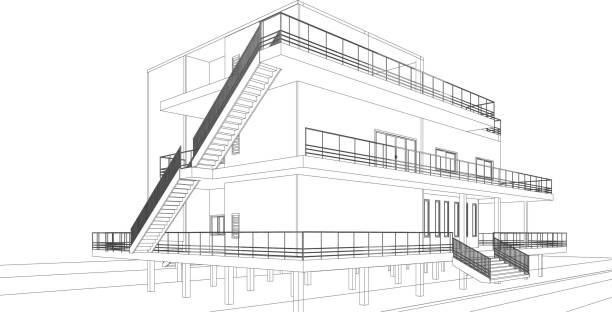Every developer in Los Angeles has that story.
It usually starts with a promising deal — the site looks perfect, the zoning seems clear, and the timeline feels achievable. But somewhere between excitement and execution, a small detail slips through the cracks. Maybe it’s a missing soils report. Maybe a traffic study was filed under the wrong case number. Or maybe, the application itself was technically “incomplete.”
Weeks pass. Then months. And what started as a simple review turns into a bureaucratic maze of correction letters, coordination calls, and rising carrying costs.
At JDJ Consulting Group, we’ve seen this pattern more times than we can count. And it’s rarely the big design moves or development ideas that hold up a project — it’s the paperwork. The small, invisible mistakes in entitlement applications that multiply as the project moves through the city’s system.
Los Angeles doesn’t forgive sloppiness in submittals. Every agency—Planning, Building and Safety, Fire, Public Works, and Transportation—has its own standards, its own language, and its own pace. You can do everything “mostly right” and still end up months behind schedule if one technical study, signature, or plan sheet doesn’t line up with the city’s expectations.
So this guide isn’t just about avoiding errors; it’s about building a smarter process. It’s about knowing what not to do — before those oversights start costing real money. Whether you’re a developer managing a multifamily project, a homeowner tackling an ADU, or an investor looking to reposition a commercial site, understanding these entitlement pitfalls can save you months of frustration.
Because in real estate, speed isn’t just convenience — it’s capital. And avoiding the most common entitlement mistakes is how smart projects stay ahead in Los Angeles.

Table of Contents
ToggleQuick Roadmap: What You’ll Learn
Before we dive into the details, here’s a quick look at what this article covers:
A simple breakdown of how the entitlement process works
The most frequent mistakes made in entitlement applications
How to prevent documentation and sequencing errors
Why technical reports and CEQA timing are critical
Practical tools, checklists, and real-world examples from Los Angeles projects
To make things easier, we’ve included tables that summarize key pitfalls and solutions throughout this article.
🏗️ Entitlement Review Process in Los Angeles
Pre-Application Review
(Planning Department)
Environmental & Technical Studies
(CEQA, Traffic, Soils)
Public Hearing or Director’s Decision
(Depending on Project Type)
City Approvals & Conditions
(Zoning, Fire, Public Works)
Source: City of Los Angeles Planning Department
Understanding The Entitlement Process
An entitlement is the city’s approval to use or develop your property in a specific way. Think of it as the legal permission to build, remodel, or change land use beyond what’s automatically allowed by zoning.
What Entitlements Typically Cover
Most entitlement applications fall into these categories:
| Type of Entitlement | Purpose | Examples |
|---|---|---|
| Zone Change | Modify existing zoning designation | Changing from R1 (residential) to R3 (multi-family) |
| Variance | Request flexibility from zoning standards | Reduced setbacks or parking requirements |
| Conditional Use Permit (CUP) | Allow specific uses under certain conditions | Opening a restaurant with alcohol service |
| Subdivision/Parcel Map | Divide or merge land parcels | Lot splits or tract developments |
| Site Plan Review | Ensure project complies with city design standards | Multi-unit or mixed-use buildings |
Each jurisdiction in Los Angeles County may handle these differently. However, the general process follows a similar pattern: pre-application, submittal, review, public hearing, and final approval.
Entitlements vs. Building Permits
One of the most common mistakes in entitlement applications comes from mixing up entitlements with permits.
| Aspect | Entitlement | Building Permit |
|---|---|---|
| Purpose | Legal approval for land use or design | Authorization to start construction |
| Timing | Early in the project lifecycle | After entitlements are approved |
| Reviewed By | Planning Department and sometimes City Council | Building and Safety Department |
| Common Documents | Zoning analysis, CEQA reports, site plans | Structural drawings, engineering plans |
Understanding this difference early prevents you from spending money on construction before land use is approved.
Why Process Variations Matter
Every city—and often every district within Los Angeles—has its own review standards. Beverly Hills, Santa Monica, and the City of Los Angeles all have different timelines, forms, and environmental triggers. Even similar projects can face different review paths depending on zoning overlays or community plans.
That’s why experienced consultants start by mapping out each agency’s steps before an application ever goes in. It’s also why skipping due diligence is one of the biggest causes of project delays (a topic we’ll cover next).
Top Categories of Mistakes in Entitlement Applications
Most problems fall into a few predictable groups. Knowing them early helps you build a process that avoids repeat errors.
Here’s a quick overview of the major mistake categories developers encounter:
| Category | Typical Problem | Impact |
|---|---|---|
| Due Diligence | Incomplete zoning or site research | Design conflicts and costly redesigns |
| Documentation | Missing forms, inconsistent plans, or wrong file types | Application rejection or restart |
| Technical Reports | Delayed or incorrect studies (traffic, soils, CEQA) | Extra review rounds and added fees |
| Zoning Misinterpretation | Misunderstanding overlays or specific plans | Non-compliance and hearing denials |
| Community Outreach | Ignoring neighborhood input | Opposition and appeals |
| Budgeting and Timing | Underestimating approval duration | Carrying costs and expired entitlements |
Group A: Due Diligence and Sequencing Mistakes
Doing your homework before you design saves time, money, and stress. Skipping this step is one of the most common mistakes in entitlement applications.
1. Skipping Early Site and Zoning Research
Many applicants rush into design without checking what their site actually allows. They assume their plan fits the zoning, only to learn later that height limits, setbacks, or overlays block approval.
This is where basic due diligence makes all the difference.
Here’s what smart developers do before any drawings begin:
Pull the official zoning map and general plan designation.
Check for overlays — hillside, coastal, historic, or specific plan areas.
Confirm any recorded easements or previous conditions of approval.
Review property records for outstanding code violations.
Visit the site in person to spot slope, access, or utility issues.
If you don’t confirm these details early, you might end up paying to redesign the project halfway through review.
2. Poor Sequencing of Tasks
Even with good research, many teams do the right tasks in the wrong order. For example, they submit plans before completing required technical studies. That often triggers “incomplete” letters from the city.
Sequencing is about timing each step correctly. You should know which reports are needed, who prepares them, and when they’re due.
A simple table helps organize this workflow:
| Step | Task | Who Handles It | When to Do It |
|---|---|---|---|
| 1 | Preliminary zoning and site research | Planner or consultant | Before design starts |
| 2 | Concept design and feasibility review | Architect and owner | After zoning check |
| 3 | Technical studies (traffic, soils, CEQA review) | Specialized consultants | Before application submittal |
| 4 | Community or council outreach | Owner or consultant | Before hearings |
| 5 | Final entitlement submittal | Planner or permit expediter | After all materials are complete |
Following a timeline like this keeps your project clean and predictable. It also signals to the city that your team is organized and prepared.
3. Ignoring Red Flags in Early Reports
Sometimes, teams order the right studies but fail to read them carefully. A geotechnical report might note unstable soil, or a traffic memo might suggest off-site improvements. Ignoring those red flags can cause costly delays later.
Always review each report for potential “showstoppers.” If something seems unclear, address it before the submittal. Adjusting early is cheaper than revising after public notice.
4. JDJ’s Tip for Smart Sequencing
At JDJ Consulting Group, we recommend creating an Entitlement Readiness Checklist at the start of every project. It lists each report, who owns it, and its current status.
That single document keeps everyone aligned — from engineers to architects to owners. More importantly, it prevents the small coordination gaps that lead to big mistakes.
The Takeaway
Most entitlement delays trace back to poor preparation, not bad luck. When you do proper due diligence and follow a clear sequence, approvals move faster and cost less.
Next, we’ll look at how documentation and submittal mistakes can derail an otherwise solid project — and how to avoid them.

Group B: Documentation and Submittal Mistakes
Even strong projects can stumble during submittal. Many mistakes in entitlement applications happen because paperwork doesn’t match what’s shown on the plans.
A missing signature, old plan set, or mismatched sheet title can all lead to a rejection at intake. Once that happens, your project must be rescheduled for another review date — often weeks later.
1. Submitting Incomplete Packages
Los Angeles planning staff won’t review an incomplete file. They’ll return it, even if you’re missing just one report. Always confirm you have every required form, study, and fee before scheduling your intake appointment.
Here’s a simple way to verify your package:
| Checklist Item | Purpose | Common Error |
|---|---|---|
| Application Form | Identifies applicant and scope | Missing signatures or outdated version |
| Plans (PDF + Hard Copy) | Illustrates design and site details | Missing sheets or inconsistent scales |
| Owner Authorization Letter | Confirms ownership consent | Wrong parcel or expired document |
| Technical Reports | Supports findings (traffic, soils, CEQA) | Old studies or conflicting data |
| Digital Uploads (ZIMAS/DSC) | Required for digital intake | Wrong file names or missing metadata |
Before submittal, check your file against the city’s official checklist — not just your consultant’s. Each case type (CUP, Zone Change, Tract Map) has unique document rules.
2. Inconsistent Plan Sets
Another common issue is when drawings in different disciplines don’t align. For example, the architectural site plan shows one driveway, but the civil plan shows another.
Those conflicts confuse reviewers and can trigger additional rounds of corrections.
To avoid that, all consultants should work from the same base CAD file and confirm consistent sheet titles, north arrows, and legends before printing.
3. Outdated or Conflicting Reports
Los Angeles departments often reject studies older than one year. If your traffic, soils, or arborist reports are outdated, update them before resubmittal.
Conflicting findings — like one report listing a slope under 15% while another lists 20% — can also raise red flags. Review every report for consistency before submission.
4. Missing or Incorrect Project Descriptions
City staff rely on the written project description to categorize your request. If that text is vague or incorrect, your application may be routed to the wrong planner or division.
Keep it concise, factual, and aligned with your plans. For example:
“A three-story, 12-unit apartment building with ground-floor parking and rooftop open space.”
Avoid marketing language like “luxury” or “boutique.” The city wants facts, not features.
📊 Top Causes of Entitlement Delays (2025)
Source: JDJ Consulting Group Case Study, 2025
Group C: Communication and Coordination Errors
Even if your paperwork is perfect, poor coordination can derail your project. This is one of the most underrated mistakes in entitlement applications.
When multiple consultants — planners, architects, engineers — work separately, details fall through the cracks.
1. Not Assigning a Single Point of Contact
Every project should have one person responsible for communication with the city. When messages come from different team members, key instructions get lost.
The point person ensures consistency, tracks review comments, and manages deadlines. This role can be the planner, expediter, or project manager — but it must be clear to everyone.
2. Ignoring Correction Letters
After your first review, you’ll likely receive a correction letter from the planner or engineer. Ignoring or delaying these responses is a serious mistake.
Always read each comment carefully, even if you disagree. Respond point-by-point in writing, and include a revised plan set showing the updates. That demonstrates cooperation and professionalism.
3. Poor Communication Among Consultants
If your traffic engineer and architect don’t coordinate, expect conflicts. A driveway location, grading line, or retaining wall might change after one report is finalized.
Set regular coordination meetings during review. Even 15-minute check-ins save weeks later.
4. Not Tracking Submittal Status
It’s common for applicants to assume their project is “in review” when it’s actually pending due to a missing fee or form. Always confirm your case number is active and assigned to a planner.
Use the Los Angeles Planning Case Tracking System to monitor progress and upload new documents as needed.
The Takeaway
Good communication shortens review time. Bad coordination stretches it out. By assigning one main contact and reviewing all responses quickly, you keep your project on track and show the city your team is serious.
Group D: Technical and Environmental Report Errors
Technical studies are a key part of most entitlement applications in Los Angeles. They show how your project affects traffic, air quality, water flow, and noise.
Many mistakes in entitlement applications happen when these studies are rushed, outdated, or incomplete. Since each department relies on them to make findings, even one missing section can stall your approval.
1. Outdated CEQA Documents
CEQA — the California Environmental Quality Act — governs most project-level environmental reviews. If your CEQA study is over a year old or doesn’t match your latest site plan, it can be rejected.
Always update your CEQA checklist and technical appendices when making design changes. Even small shifts in unit count or building height may trigger new thresholds.
Tip: keep one “master environmental folder” with your air quality, traffic, and noise studies in sync. That prevents data mismatches during later reviews.
2. Missing Specialized Studies
Depending on the site, your project might require more than just standard CEQA forms. Common extra reports include:
Tree reports for protected species (like coast live oak)
Hydrology studies for hillside grading
Cultural resource surveys for historic areas
Geotechnical investigations for steep lots
Fire access or brush clearance plans for Very High Fire Hazard zones
Skipping these early often leads to “incomplete” letters during review. It’s far better to overprepare and confirm study requirements during your pre-filing meeting.
3. Inconsistent Technical Data
A traffic report might show 18 units, while your site plan shows 16. A noise study might reference the wrong address.
These small inconsistencies signal to reviewers that the team isn’t aligned. Always cross-check report data before submittal to ensure every study references the same version of the project.
4. Overlooking Departmental Overlaps
In Los Angeles, multiple agencies review environmental data — not just Planning. For example, a stormwater plan might require both Public Works and Building and Safety approval.
Failing to coordinate between agencies can cause repeat reviews or even conflicting comments.
At JDJ, we often prepare a Technical Review Matrix early in the process to keep everyone on the same page. Here’s a simple example:
| Agency | Required Study | Timing | Notes |
|---|---|---|---|
| LA Planning Department | CEQA Checklist | Early stage | Must match latest plans |
| Public Works | Hydrology Study | Before grading | Include infiltration analysis |
| LADOT | Traffic Study | Before hearing | Update trip counts as needed |
| Fire Department | Access & Brush Report | Before approval | Verify hydrant locations |
This approach keeps reports organized and reduces duplicate comments later.
Group E: Legal and Zoning Interpretation Mistakes
This next group of errors is where many projects lose momentum. Zoning rules in Los Angeles are complex, and small misunderstandings often lead to big setbacks.
1. Misreading Zoning Designations
Each parcel has a zoning code that defines what can be built there. Reading that code wrong — for example, confusing R3-1 with R3-1XL — can cause your entire entitlement request to be denied.
Always verify your zoning data using ZIMAS, the city’s online mapping tool. Don’t rely on old assessor records or property listings.
2. Ignoring Overlay Zones and Community Plans
Overlay zones add extra conditions on top of base zoning. Examples include:
TOC (Transit-Oriented Communities)
Hillside Areas
Coastal Zones
Each has its own design and density limits. Overlooking these details is one of the most frequent mistakes in entitlement applications we see from first-time developers.
A property in a TOC area might allow bonus units, but only if you follow affordability and parking rules. In an HPOZ, you’ll need design approval from a review board before your case even reaches Planning.
🧮 Project Delay Cost Estimator
Estimate how much each week of delay costs your development.
3. Overestimating Density or Floor Area
Many project teams assume they can build to the maximum limits shown in the zoning code. But height district caps, slope rules, and open space requirements can reduce what’s actually allowed.
Before finalizing your concept, confirm your buildable area through a zoning interpretation memo or preliminary review meeting. That document can prevent costly redesigns later.
4. Missing or Misclassifying Existing Uses
If your site already has tenants or a prior nonconforming use, those details must be disclosed in the application. Failing to do so can delay hearings or trigger extra conditions.
Always verify your property’s existing use code and occupancy history through city records before submitting.
The Takeaway
Zoning errors are preventable but costly. A single misread overlay or density miscalculation can reset months of progress. Always confirm your property’s exact zoning, overlays, and use history early — ideally before your first design draft.

Group F: Timeline and Process Management Mistakes
Even experienced teams struggle with timing. The Los Angeles entitlement process isn’t just complex — it’s slow. Missing one submittal window or review deadline can push your project months behind schedule.
These mistakes in entitlement applications usually happen because developers underestimate how long each stage takes or fail to plan for city review cycles.
1. Misjudging Review Time
A standard Conditional Use Permit can take six to nine months. Zone Changes or Tract Maps can take a year or more.
But many applicants assume it’ll move faster — especially after pre-application meetings. That’s rarely the case. Review time depends on staffing, department backlog, and whether public hearings are required.
It’s smarter to plan for the long timeline, then adjust if approvals come early. Overpromising to investors or clients only adds pressure when delays occur.
2. Not Tracking Key Milestones
Every entitlement has milestone dates — submittal, completeness review, environmental clearance, hearing, and appeal. Losing track of one means missing notices or resubmittal deadlines.
Keep a simple tracking sheet for your project. Example:
| Milestone | Target Date | Actual Date | Notes |
|---|---|---|---|
| Application Submittal | Jan 10, 2025 | Jan 15, 2025 | Rescheduled by planner |
| Corrections Due | Feb 20, 2025 | Feb 25, 2025 | Added revised site plan |
| Hearing Scheduled | Apr 30, 2025 | — | Waiting for LADOT clearance |
| CEQA Determination | May 10, 2025 | — | In environmental review |
Having this document keeps the entire team accountable.
3. Overlapping Phases Too Early
Some developers start detailed construction drawings while entitlements are still under review. That’s risky. If the city asks for design revisions, those drawings become wasted work.
Wait until your entitlement conditions are final before advancing to full construction documents.
4. Ignoring Seasonal or Political Timing
Public hearings slow down during holidays, election years, or budget cycles. It’s easy to overlook these timing issues, but they can add weeks.
Plan around known slow periods, and file early in the quarter to catch internal scheduling windows.
The Takeaway
Good entitlement management is about timing and structure. Plan for delays, track every milestone, and don’t start technical drawings too early. A project that’s managed carefully almost always moves faster in the end.
Group G: Public and Agency Hearing Pitfalls
Even with clean paperwork and perfect reports, your project still faces one unpredictable stage — public hearings.
This is where planning commissions, neighborhood councils, and city agencies weigh in. Many mistakes in entitlement applications happen here because teams underestimate how public feedback or presentation style affects approval.
1. Poor Preparation for Hearings
The biggest mistake is walking into a hearing unprepared. Every presentation should include:
A clear project summary (what, where, and why)
Photos or renderings that show context
Responses to key concerns raised during review
If you can’t explain your project in two minutes, the hearing officer won’t follow.
At JDJ, we often coach clients on presentation flow — starting with site context, then benefits, then compliance with planning goals. It builds confidence and credibility.
2. Failing to Engage Stakeholders Early
Neighborhood opposition can delay or derail approvals. Many developers wait until the public hearing to introduce their project — a major mistake.
Engage early. Meet with neighborhood councils or homeowner associations before filing. Listen to concerns and adjust where practical.
Projects that show early outreach are often viewed more favorably by city staff and commissioners.
🧠 Are You Entitlement Ready?
3. Incomplete Hearing Materials
Hearing packets often require additional materials beyond your main plans. Common examples include:
Hearing notice proof
Radius maps and labels
Updated site photos
Applicant statement or findings
Missing even one of these can cause your case to be continued to another date. Always double-check the hearing packet checklist at least one week in advance.
4. Not Following Up After Approval
Approval isn’t the finish line. Many conditions require follow-up submittals, like covenant recordings or revised plan sheets.
If you miss these steps, your project can’t move to the building permit phase. Always request a Final Entitlement Clearance Letter before closing out your case.
The Takeaway
Public and agency hearings aren’t just formalities — they’re the make-or-break moments of the entitlement process. Preparation, outreach, and clear presentation make a lasting difference.
Group H: Consultant Coordination and Quality Control
The last category of mistakes in entitlement applications often comes from inside the project team. Even when every form and study looks right, miscommunication among consultants can create costly inconsistencies.
Entitlement projects bring together many professionals — planners, architects, engineers, traffic consultants, and environmental specialists. Without clear coordination, details can easily drift apart.
1. Working in Silos
When each consultant works independently, errors multiply. For example, the architect might revise a unit layout, but the traffic consultant doesn’t update trip counts. The result? Conflicting data in your reports.
To prevent this, share a single “master plan set” that all consultants update together. One change triggers a coordinated review instead of a chain reaction of revisions later.
2. Skipping Internal Reviews
Never submit directly to the city without an internal review first. Have one person — ideally your project manager or entitlement lead — read the entire submittal package line by line.
This review should check:
Are the plans labeled and consistent?
Do all reports match the current design?
Are applicant names and parcel numbers identical across forms?
A 30-minute internal audit often catches weeks of avoidable delay.
3. Relying Too Heavily on City Staff
City planners and engineers can guide you, but they won’t fix your documents. Their job is to review, not to advise.
Teams that depend too much on informal feedback risk submitting weak or incomplete files. Use city guidance as reference — not as a replacement for your own due diligence.
4. Missing Post-Approval Coordination
After approval, most entitlements come with conditions — like landscaping changes, utility coordination, or environmental mitigation. Each condition may require follow-up from different consultants.
Failing to assign those tasks early can stall your project right before permit issuance. Always create a Condition Tracking Log immediately after approval.
| Condition Type | Responsible Party | Status | Notes |
|---|---|---|---|
| Landscaping Plan Revision | Landscape Architect | Pending | Requires LADOT review |
| Grading Plan Update | Civil Engineer | Complete | Uploaded to Planning Portal |
| CEQA Mitigation Report | Environmental Consultant | In Progress | Submit by Nov 2025 |
| Covenant Recording | Legal Team | Pending | Awaiting document signature |
This simple log keeps everyone accountable and ensures no loose ends before construction.
Final Thoughts: Building Stronger Entitlement Applications
Entitlements are the backbone of any real estate project in Los Angeles. Done right, they give you confidence and predictability. Done wrong, they cause frustration, cost overruns, and lost opportunities.
Most mistakes in entitlement applications come from preventable issues — poor coordination, inconsistent reports, or unclear communication. By understanding how these errors happen, you can plan smarter and move through the city review system with less friction.

At JDJ Consulting Group, our team focuses on one goal: helping clients secure clear, compliant approvals on their first submission. We bridge the gap between design and regulation — making sure your submittal is complete, consistent, and professionally presented.
We believe entitlement success isn’t about luck or connections. It’s about preparation, accuracy, and strategy. When every consultant, report, and document speaks the same language, approvals follow naturally.
Summary Table: Common Mistakes and How to Fix Them
| Mistake Category | Common Issue | Smart Fix |
|---|---|---|
| Planning and Zoning | Misreading zoning data or overlays | Verify through ZIMAS and community plans early |
| Documentation | Incomplete or inconsistent plan sets | Use city-issued checklist and unified CAD base |
| Technical Reports | Old CEQA or traffic studies | Refresh studies with updated data before filing |
| Coordination | Multiple consultants working separately | Assign one main contact and shared plan folder |
| Timing | Ignoring milestone dates | Maintain tracking sheet and calendar reminders |
| Public Hearings | Poor presentation or lack of outreach | Prepare visuals, rehearse, and meet stakeholders early |
| Post-Approval | Missing condition follow-ups | Create a condition tracking log for all consultants |
Closing Note
The entitlement process doesn’t have to feel like a maze. With early due diligence, coordinated documentation, and steady communication, you can avoid most of the mistakes that slow down approvals.
If you’re planning a new project in Los Angeles — residential, commercial, or mixed-use — JDJ Consulting Group can help you prepare an airtight entitlement package that gets reviewed efficiently and approved with confidence. Book your free consultation with our expert Los Angeles based consultants here: https://jdj-consulting.com/book-consultation/
📈 Average Entitlement Processing Times (Months)
Source: JDJ Consulting Group Internal Data, 2025
Need Help with Your Entitlement Application?
Avoid costly mistakes and delays — get professional guidance from JDJ Consulting Group.
📞 Schedule a ConsultationFAQs About Mistakes in Entitlement Applications
What are the most common mistakes in entitlement applications?
The most frequent mistakes include missing technical studies, incorrect zoning data, and incomplete environmental reports.
Other common issues are:
Not coordinating with all city departments early
Submitting outdated site plans or project data
Ignoring CEQA requirements
Each of these can trigger costly delays or rejection during city review. A professional entitlement consultant helps identify and correct these before submission.
How do small errors delay entitlement approvals?
Small errors—like a wrong parcel number or missing signature—often send applications back for correction.
That means:
Losing your place in the review queue
Additional weeks or months of waiting
Possible resubmittal fees
In cities like Los Angeles, where processing timelines are already long, these small mistakes can push approvals months behind schedule.
Why are entitlement applications in Los Angeles so complex?
Entitlement applications involve several agencies: Planning, Building and Safety, Public Works, Fire Department, and Transportation.
Each has its own standards and review process. The complexity comes from:
Overlapping regulations
Multiple zoning overlays
Environmental compliance (like CEQA or hillside ordinances)
This layered system makes coordination critical to avoid conflicting approvals or redundant studies.
Can I submit entitlement documents without a consultant?
Yes, but it’s risky. Many applicants underestimate how technical the process is.
Without a consultant, you may:
Misinterpret zoning codes
Miss supporting studies (e.g., traffic or shadow analyses)
Face more rounds of correction
Hiring an entitlement consultant ensures your submittal meets all requirements the first time, reducing project delays and costs.
How long does the entitlement process usually take in Los Angeles?
Timelines vary by project type and location.
Small remodels or additions: 3–6 months
New construction or multi-unit housing: 9–18 months
Major developments (mixed-use, commercial): up to 24 months or more
Proper preparation and coordination with agencies can shorten these timelines significantly.
What is the biggest cause of entitlement delays?
Incomplete submittals are the number one cause of delays.
Other major causes include:
Ignoring public hearing notice requirements
Late responses to city corrections
Not tracking departmental review timelines
Proactive communication with city planners and expeditors helps minimize these issues.
How can consultants help avoid entitlement mistakes?
Consultants act as project managers between you and the city. They:
Review all application materials
Coordinate with architects, engineers, and city staff
Ensure studies meet CEQA and zoning standards
By handling these details, they help you avoid costly resubmittals and approval gaps between departments.
What happens if your entitlement application is rejected?
If rejected, you’ll receive a “Correction Notice” or “Denial Letter” explaining the issues. You can:
Revise and resubmit your application
Appeal the decision (depending on case type)
Engage a consultant to review missing documentation
The key is addressing all deficiencies promptly to maintain project momentum.
How can early planning help prevent entitlement issues?
Early planning helps you identify constraints before spending on design.
This includes:
Reviewing zoning and land-use limits
Checking lot size, setbacks, and FAR ratios
Assessing environmental overlays
This proactive review ensures your project concept matches what the city will approve, saving months in revisions later.
What are zoning inconsistencies and how do they affect approval?
Zoning inconsistencies occur when project details—like height or density—don’t match your property’s zone.
That can lead to:
Rejections during preliminary review
The need for variances or conditional use permits
Always verify zoning details and consult the Los Angeles Zoning Information and Map Access System (ZIMAS) before submitting.
How do public hearings impact entitlement approval?
Public hearings allow community members to voice concerns.
Mistakes here include:
Failing to post notices correctly
Ignoring neighborhood input before the hearing
These errors can delay your project or require additional conditions. Preparing early responses and attending hearings with your consultant makes a difference.
What’s the difference between an entitlement and a building permit?
An entitlement grants permission to use land a certain way under zoning laws.
A building permit allows actual construction.
You must secure entitlements first before the city will issue permits. Confusing the two or skipping entitlement review often causes major project delays.
How do CEQA requirements tie into entitlement mistakes?
CEQA (California Environmental Quality Act) reviews environmental impacts.
Common CEQA mistakes include:
Submitting the wrong environmental form
Overlooking cumulative impact studies
Failing to circulate reports properly
Each CEQA misstep can cause the city to pause your review, adding months to processing time.
Are entitlement mistakes more common in hillside or coastal zones?
Yes. These zones have special overlays and stricter regulations.
For example:
Hillside areas require grading, soil, and view impact studies
Coastal zones often need additional reviews by the Coastal Commission
Missing these steps can stall your project indefinitely.
What documents are most often missing in entitlement submittals?
Frequently missing documents include:
Updated site surveys
Title reports
Utility and drainage plans
Public noticing affidavits
Double-check your submittal checklist and confirm each department’s unique documentation requirements before filing.
Can digital submittals reduce entitlement errors?
Yes, online portals like Los Angeles’ ePlanLA help track and upload all documents in one place.
Benefits include:
Real-time correction tracking
Fewer lost files
Faster communication with city staff
However, digital errors still occur if filenames or versions don’t match city standards.
What role do neighborhood councils play in entitlement reviews?
Neighborhood councils give advisory opinions on local projects.
Common mistakes include ignoring their early input or missing meeting deadlines.
By engaging them early and presenting clear visuals, you can reduce objections and build support before the city hearing.
How can developers manage multiple agency reviews efficiently?
Use a central project manager or entitlement consultant to track all agency timelines.
Best practices:
Create a shared document tracker
Log all communications
Schedule weekly review updates
Coordinating these efforts prevents missing responses or conflicting city approvals.
When should you bring in an entitlement consultant?
Ideally, hire a consultant before submitting preliminary designs.
Early involvement helps with:
Zoning research
Environmental screening
Feasibility analysis
This early planning ensures the architectural team designs within zoning limits, avoiding rework later.
How can I ensure my entitlement application is “review-ready”?
Before submission, make sure you have:
A complete application form
All technical reports and environmental studies
Correct zoning data and parcel numbers
Public notice documents (if required)
Having a consultant review your full package ensures it meets city standards and avoids rejection.






